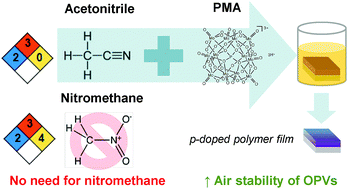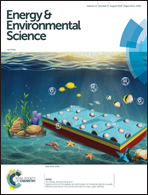Stable solvent for solution-based electrical doping of semiconducting polymer films and its application to organic solar cells†
Abstract
The immersion of polymeric semiconducting films into a polyoxometalate (PMA) solution was found to lead to electrical doping over a limited depth, enabling the fabrication of organic photovoltaic devices with simplified geometry; yet, the technique was highly solvent selective and the use of nitromethane was found to be limiting. Here, we report on the use of acetonitrile as an alternative solvent to nitromethane. Morphology studies on pristine and PMA doped P3HT films suggest that dopants reside in between the lamella of the polymer, but cause no distortion to the P3HT π–π stacking. With this information, we propose an explanation for the observed solvent-selectivity of the doping method. Degradation studies reveal a superior stability of films doped with PMA in acetonitrile. Based on these findings, we believe that the post-process immersion technique, when dissolving PMA in acetonitrile, is a more suitable candidate to conduct solution-based electrical p-doping of organic semiconductors on an industrial scale.

- This article is part of the themed collection: 2018 Energy and Environmental Science HOT Articles


 Please wait while we load your content...
Please wait while we load your content...
